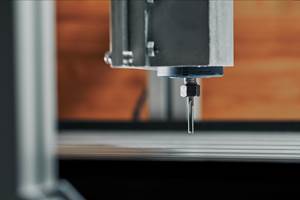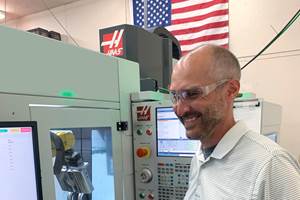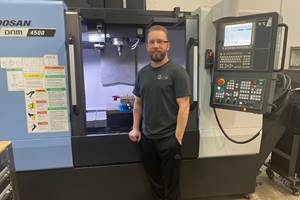Benefits And Costs Of Process Simulation
For companies that have implemented digital manufacturing, the return on investment is there . . . but the scope of that investment goes well beyond the price of software.
For companies that have implemented digital manufacturing, the return on investment is there . . . but the scope of that investment goes well beyond the price of software. That was the conclusion of a study by D.H. Brown Associates, an information technology consulting firm that analyzed digital manufacturing by interviewing managers involved in justifying the technology for large manufacturers in the aerospace, automotive, and heavy equipment industries.
“Digital manufacturing” means simulating the manufacturing process using 3D CAD models. The goal is to streamline manufacturing process development time, largely by catching bugs and inefficiencies in the simulation instead of in real life. The technology applies to more than machining. Manufacturers facing high capital equipment costs also use it to optimize assembly, welding and other processes before tooling, machine motions, and machine placement are finalized.
The potential payback includes reduced ramp-up time for new processes, as well as the problems—like collisions—that are avoided early. However, in many companies, achieving these results can require nothing short of a culture change. For digital manufacturing to be effective, those who develop new processes must be willing to trust what they see on screen. Thus, process designers are asked to make a leap similar to the one that product designers were asked to make about a decade ago, back when 3D CAD modeling was new.
This table from D. H. Brown Associates lists typical considerations for companies attempting to justify digital manufacturing.Costs
• Digital manufacturing software
• Computer hardware
• New business process development
• Culture change implementation
• Software training
• New business process training
• Extra labor required to achieve proficiency in new software and a new business process
Benefits
• Quicker time to market
• Reduced per-unit production cost
• Reduced overall labor cost
• Higher quality manufacturing process
• Reduced manufacturing process development cost
• Reduced rework and faster part learn-out
• Higher reuse of existing manufacturing equipment
Another potentially large investment is the effort required to input the data necessary for the system to develop its models. In fact, software company Deneb Robotics (Troy, Michigan) is fundamentally changing its manufacturing simulation products, and one of its key reasons for doing so is to reduce the scope of this data feeding task. In the past, this company’s systems for simulating machining, assembly, welding and other operations were limited in their ability to share data seamlessly with one another. However, versions of these products now being released can freely draw from a common database. These systems also share a modeling kernel in common—the kernel used in CATIA. (The company is a subsidiary of CATIA developer Dassault Systems.)
Deneb’s module for simulating machining processes is called Virtual NC. The system relies on available CAD data to develop 3D models of the machine tool, tooling, and workpiece, and uses these models to simulate NC tool paths and look for collisions. An example of where this software makes sense comes from a Lockheed Martin Energy Systems plant in Oak Ridge, Tennessee. By using the simulation software to test 500 new programs for an eight-axis milling machine, Lockheed Martin programmers cut their total program prove-out time in half. Also, programmers were able to test and debug probing subroutines, as well as a postprocessor, before the machine had even been built.
The software also let programmers make precise corrections to the process. In one case where the software detected a collision, the programmer responded by extending the tool about two inches—the minimum change necessary for the collision to be avoided. Because this change was so small, the machine operator was called in to watch the simulation. He had to be prepared for how narrowly the machine would avoid hitting the work.—PCZ
Related Content
5 G-Code Tips for Increasing CNC Efficiency
Optimizing G code is a low-cost way to improve CNC efficiency without sacrificing usability and safety.
Read MoreFive Safety Considerations for CNC Machinists
Safety in CNC environments is essential for users – and for productivity. Consider these 5 points to avoid injury, part failure and downtime.
Read More5 Reasons Why Machine Shop Ownership Is Changing
Mergers, acquisitions and other ownership changes are an effect of Boomer-age shop owners retiring, but only in part. Also important: The way we think about machining has changed.
Read MoreImproving Workflows in Small Shops with Custom ERP
Small shops might not be ready for all of the functionality of an off-the-shelf ERP system, but modular, custom ERP programs can help improve workflow while providing the flexibility to change as shops grow.
Read MoreRead Next
A History of Precision: The Invention and Evolution of Swiss-Style Machining
In the late 1800s, a new technology — Swiss-type machines — emerged to serve Switzerland’s growing watchmaking industry. Today, Swiss-machined parts are ubiquitous, and there’s a good reason for that: No other machining technology can produce tiny, complex components more efficiently or at higher quality.
Read MoreObscure CNC Features That Can Help (or Hurt) You
You cannot begin to take advantage of an available feature if you do not know it exists. Conversely, you will not know how to avoid CNC features that may be detrimental to your process.
Read MoreEncountering Surface Finishes in the Everyday World
Surface measurement is becoming increasingly important to ensure proper performance of a manufactured product. Advanced surface measurement tools are not only beneficial in the manufacturing industry but also have unconventional applications.
Read More













.png;maxWidth=300;quality=90)



 – Medium Rectangle (1).png;maxWidth=300;quality=90)







